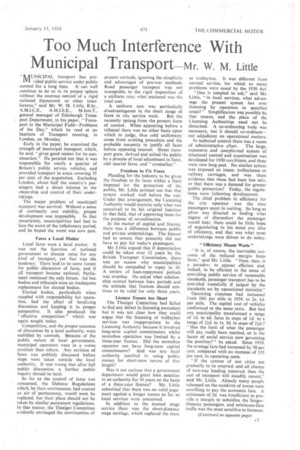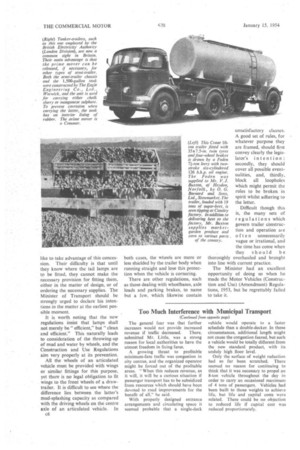Too Much. Interference With
Page 45

Page 44

If you've noticed an error in this article please click here to report it so we can fix it.
Municipal Transport—Mr. W. M. Little " MUNICIPAL transport has provided public service under public
control for a long time. It can well continue to do so in its proper sphere without the onerous control of a rigid national framework or •other interference," said Mr. W. M. Little, B.Sc., A.M.I.C.E., A.M.I.E.E., M.Inst.T., general manager of Edinburgh Trans .. port Department, in his paper, Transport in the Municipal Field—Problems of the Day," which he read at an Institute of Transport meeting, in London, on Monday.
Early in the paper, he examined the strength of municipal transport, which, he said, "gives good reason for its continuation." He pointed out that it was responsible for nearly a quarter of Britain's public service vehicles, and provided transport in areas covering 35 per cent. of the population. Excluding
• London, abouthalf the country's passengers had a direct interest in the
• ownership and control of• their undertakings.
The major problem of municipal transport was survival. Without a sense of continuity and stability, proper development was impossible. In that uncertainty, municipalities had had to face the worst of the inflationary period, and he hoped the worst was now past.
Fares a Local Matter Local fares were a local matter. It was not the function of national government to discuss rates for any kind of transport, yet that was the tendency. There had to be some forum for public discussion of fares, and if all transport became national, Parliament reMained the only forum. Ad hoc bodies and tribunals were an inadequate replacement for elected bodies.
Elected bodies, particularly when coupled wiOr responsibility for operation, had the effect of localizing discussion and keeping it in proper perspective. It also produced the effective competition" which was again sought today.
Competition, and the proper outcome of discussion by .a local authority, were stultified by controls. Because of the public nature of local government, municipal operators were in a worse position than others. Any revision of fares was publicly discussed before steps were taken outside the 1=1 authority. It was wrong that after full public discussion, a further public inquiry should be held.
So far as the control of fares was • concerned, the Defence Regulations which, by their continuance, had created an air of permanency, would soon be replaced, but their place should not be taken by similar permanent regulations. In that matter, the Thesigei Committee evidently envisaged the continuation of present controls, ignoring the simplicity and advantages of pre-war methods. Road passenger transport was not susceptible to the rigid imposition of a uniform rate; what mattered was the total cost.
A uniform rate was particularly disadvantageous in the short range of fares in city service work. But the necessity sprang from the present form of control, When appearing before a tribunal there was no other basis upon which to judge, thus cold uniformity arose from existing procedure and the probable necessity to justify all fares before opposing counsel, Street transport grew, thrived and suited the public by a process of local adjustment in fares, odd special fares, and "anomalies."
Freedom to Fix Fares Pleading for the industry to be given the freedom to fix fares within a limit imposed for the protection of the public, Mr. Little pointed out that that system worked• well before the war. Under that arrangement, the Licensing Authority would exercise only what was conceived to be his original function in that field, that of approving fares for the purpose of co-ordination.
In the matter of capital and finance. there was a difference between public and private undertakings. The former had to ensure that posterity did not have to pay for today's passengers.
Mr. Little argued that if depreciation could be taken over 12 years by the British Transport Commission, there was no reason why municipalities should be compelled to repay in 10. A review of loan-repayment periods was overdue. He asked what relationship existed between loan periods and the attitude that licences should continue to be valid for only three years.
Licence Tenure too Short The Thesiger Committee had failed to find any defect in licensing procedure but it was not clear how they could argue that the licensing of trolleybus services was inappropriate to the Licensing Authority because it involved long-term capital commitments whilst motorbus operation was limited by a three-year licence. Did the motorbus operator not have long-term capital commitments? And was any local authority justified in using public money for short-term tenure of that length?
Was it not curious that a government department would grant loan sanction to an authority for 10 years on the basis of a three-year licence? Mr. Little submitted that there was no valid argument against a longer tenure so tar as local services were concerned.
In addition to the normal stage service there was the short-distance stage carriage, which replaced the tram or trolley bus. It was different from normal service, for which so many problems were eased by the 1930 Act.
" One is tempted to ask," said Mr. Little, " in local services, what advantage the present system has ovet licensing by operators in specified areas?" Simplification was possible by that means, and the place of the Licensing Authorities need not be disturbed. A co-ordinating body was necessary, but it should co-ordinate— not adjudicate on operational matters.
In technical control there was a waste of administrative effort. The large, expensive and complicated system of structural control and examination was developed for 1930 conditions, and these were now long past. No similar system was imposed on trams, trolleybuses or railway carriages, and was there evidence that these had been less safe, or that there was a demand for greater public protection? Today, the regulations were following development.
The chief problem in efficiency for the city operator was the time passengers spent in waiting. So long as effort was directed to finding what degree of discomfort the passenger would bear, there could be little hope of engendering in his mind any idea of efficiency, and that was what most undertakings were driven to do today.
"Efficiency Means Waste" "
it is, of course, the inevitable outcome of the reduced margin from fares," said Mr. Little. "Here, then, is a paradox: to appear efficient and, indeed, to be efficient in the sense of providing public service of reasonable standards, passenger transport has to be provided wastefully if judged by the standards set by operational statistics."
Operating expenses had increased from 10d. per mile in 1939, to 2s. Id. per mile. The capital cost of vehicles conformed to the same ratio. But had any municipality transformed a range of Id. to 6d. fares in steps of ld. to a range of 24d. to Is. 3d. in steps of 21d.?
Has the limit of what the passenger will pay really been reached, or is the factor of social service now governing the position?" he asked. Since 1939, the average fare had increased by 70 pet cent, compared with an increase of 155 per cent, in operating costs.
If the centres of our cities are gradually to be emptied, and all chance of two-way loading removed, then the cost of transport will steadily mount," said Mr. Little. Already many people rehoused on the outskirts of towns were unwilling to pay the economic fare. A minimum of 2d. was insufficient to proside a margin to subsidize the longerdistance passengers, and minimum-fare traffic was the most sensitive to increase.
The general fear was that further increases would not provide increased
revenue if traffic decreased. There, submitted Mr. Little, was a strong reason for local authorities to have the utmost freedom in fixing fares.
A growing threat to profitable minimum-fare traffic was congestion in city centres. and the organized operator might be forced out of the profitable areas. "When this reduces revenue, as it will, it will be a curious situation if passenger transport has to be subsidized from resources which should have been devoted to road improvements for the benefit of all," he said.
With properly designed entrance arrangements and circulating space it seemed probable that a single-deck vehicle would operate to a faster schedule than a double-decker. In those circumstances, additional length might not cause the congestion feared, but such a vehicle would be totally different from the new standard product, with its unduly high floor level.
Only the surface of weight reduction had so far been scratched. There seemed no reason for continuing to think that it was necessary to propel an 8-ton vehicle throughout the day in order to carry an occasional maximum of 4 tons of passengers. Vehicles had been built to those weights to achieve life, but life and capital costs were related. There could be no objection to reduced life if capital cost was reduced proportionately.




































































































